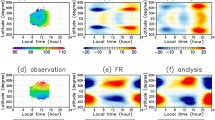Abstract
Water vapour tracers can provide useful information on winds at ≈ 500mb by observing the 6·7μ radiances. This fills the data gap in the cloud motion winds provided by conventional meteorological geostationary satellites. There is no geostationary satellite at present over the Indian Ocean with 6·7μ imaging capability to provide mid-tropospheric winds. The potentials of 6·7μ radiances, available from polar orbiting satellites, for mid-tropospheric circulation features have been examined in this study. Tiros-N satellite data of May 1979 and ECMWF level-IIIb wind data were analysed to relate the radiances with the streamlines. We find that the radiances of 6·7μ from orbiting satellites agree well with the wind field.
Similar content being viewed by others
References
Eigenwillig N and Fischer H 1982 Determination of mid-tropospheric wind vectors by tracking pure water vapour structures in METEOSAT water vapour image sequences;Bull. Am. Meteorol. Soc. 63 44–58
Joshi P C, Kishtwal C M, Narayanan M S, Sharma O P and Upadhyay H C 1987 Assessment of the use of satellite derived winds in monsoon forecasting using a general circulation model;Adv. Space Res. 7 353–356
Joshi P C, Simon B and Patra S K 1989 Use of NOAA temperature sounding data in long range forecasting of south-west monsoon rainfall;Indian J. Radio Space Phys. 18 117–119
Kidwell K B 1986NOAA polar orbiter data user's guide. US Dept. of Commerce, Washington, Chapter 4, p. 24
Rodgers E B, Salomonson V V and Kyle H L 1976 Upper tropospheric dynamics as reflected in Nimbus-4 THIR 6·7μ data;J. Geophys. Res. 81 5749–5758
Schanda E 1986Physical fundamentals of remote sensing (Berlin: Springer-Verlag)
Shukla J and Mooley D A 1987 Empirical prediction of the summer monsoon rainfall over India;Mon. Weath. Rev. 115 695–703
Smith W L 1968 An improved method for calculating tropospheric temperature and moisture from satellite radiometer measurements;Mon. Weath. Rev. 96 387–396
Stewart T R, Hayden C M and Smith W L 1985 A note on water vapour wind tracking using VAS data on McIDAS;Bull. Am. Meteorol. Soc. 66 1111–1115
Strenka J, Allison L J and Salomonson V V 1973 Application of Nimbus-4 THIR 6·7μ observations to regional and global moisture and wind field analysis;J. Appl. Meteorol. 12 386–395
Author information
Authors and Affiliations
Rights and permissions
About this article
Cite this article
Narayanan, M.S., Pal, P.K., Joshi, P.C. et al. Observations of mid-troposhheric circulation from water vapour radiances of polar orbiting satellites. Proc. Indian Acad. Sci. (Earth Planet Sci.) 98, 247–254 (1989). https://doi.org/10.1007/BF02881827
Received:
Revised:
Issue Date:
DOI: https://doi.org/10.1007/BF02881827




